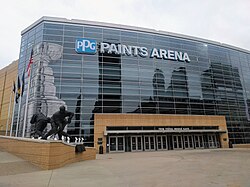Top Qs
Timeline
Chat
Perspective
2020–21 NCAA Division I men's ice hockey season
From Wikipedia, the free encyclopedia
Remove ads
The 2020–21 NCAA Division I men's ice hockey season began on November 14, 2020, and concluded with the Frozen Four on April 10, 2021. Due to the cancellation of the previous year's tournament due to COVID-19 pandemic, this was the 73rd season in which an NCAA ice hockey championship was held, and was US college hockey's 127th year overall.
Due to concerns related to the pandemic, the start of the season was delayed until what would have normally been the 8th week of play. Despite having to contend with contend with cancellations and delays due to the pandemic, the season was completed. Massachusetts won their first national championship, ending the 4-year run of NCHC teams.
Remove ads
Polls
Regular season
Summarize
Perspective
Due to difficulties in scheduling, Arizona State entered into a scheduling alliance with the Big Ten while LIU did the same with Atlantic Hockey. Both teams remained independent programs and will not be considered for conference championships.[1]
Standings
Remove ads
PairWise Rankings
Summarize
Perspective
The PairWise Rankings (PWR) are a statistical tool designed to approximate the process by which the NCAA selection committee decides which teams get at-large bids to the 16-team NCAA tournament. Although the NCAA selection committee does not use the PWR as presented by USCHO, the PWR has been accurate in predicting which teams will make the tournament field.
For Division I men, all teams are included in comparisons starting in the 2013–14 season (formerly, only teams with a Ratings Percentage Index of .500 or above, or teams under consideration, were included). The PWR method compares each team with every other such team, with the winner of each “comparison” earning one PWR point. After all comparisons are made, the points are totaled up and rankings listed accordingly.
With 61 Division I men's teams, the greatest number of PWR points any team could earn is 60, winning the comparison with every other team. Meanwhile, a team that lost all of its comparisons would have no PWR points.
Teams are then ranked by PWR point total, with ties broken by the teams’ RPI ratings, which starting in 2013-14 is weighted for home and road games and includes a quality wins bonus (QWB) for beating teams in the top 20 of the RPI (it also is weighted for home and road).
When it comes to comparing teams, the PWR uses three criteria which are combined to make a comparison: RPI, record against common opponents and head-to-head competition. Starting in 2013–14, the comparison of record against teams under consideration was dropped because all teams are now under comparison.[4]
Due to the COVID-19 pandemic, most teams played a very small selection of intraconference games, if any at all. As a result, the PairWise rankings would not be used as the primary measuring tool for determining which teams would receive at-large bids for the NCAA tournament. The ranking would only be used to differentiate between teams within their own conferences.[5] The PWR will likely be used as the primary ranking system once a full NCAA season is played.
Remove ads
Player stats
Scoring leaders
[7]
GP = Games played; G = Goals; A = Assists; Pts = Points; PIM = Penalty minutes
Leading goaltenders
The following goaltenders lead the NCAA in goals against average, minimum 1/3 of team's minutes played.[7]
GP = Games played; Min = Minutes played; W = Wins; L = Losses; T = Ties; GA = Goals against; SO = Shutouts; SV% = Save percentage; GAA = Goals against average
Remove ads
Tournament bracket
| Regional semifinals March 26–27 | Regional Finals March 27–28 | Semifinals April 8 | Championship April 10 | ||||||||||||||||
| 1 | North Dakota (1) | 5 | |||||||||||||||||
| 4 | American International | 1 | |||||||||||||||||
| 1 | North Dakota (1) | 2 | |||||||||||||||||
| Midwest – Fargo – Fri/Sat | |||||||||||||||||||
| 3 | Minnesota Duluth | 3***** | |||||||||||||||||
| 2 | – | ||||||||||||||||||
| 3 | Minnesota Duluth | – | |||||||||||||||||
| MW3 | Minnesota Duluth | 2 | |||||||||||||||||
| E2 | Massachusetts | 3* | |||||||||||||||||
| 1 | Wisconsin (4) | 3 | |||||||||||||||||
| 4 | Bemidji State | 6 | |||||||||||||||||
| 4 | Bemidji State | 0 | |||||||||||||||||
| East – Bridgeport – Fri/Sat | |||||||||||||||||||
| 2 | Massachusetts | 4 | |||||||||||||||||
| 2 | Massachusetts | 5 | |||||||||||||||||
| 3 | Lake Superior State | 1 | |||||||||||||||||
| E2 | Massachusetts | 5 | |||||||||||||||||
| NE2 | St. Cloud State | 0 | |||||||||||||||||
| 1 | Minnesota (3) | 7 | |||||||||||||||||
| 4 | Omaha | 2 | |||||||||||||||||
| 1 | Minnesota (3) | 0 | |||||||||||||||||
| West – Loveland – Sat/Sun | |||||||||||||||||||
| 2 | Minnesota State | 4 | |||||||||||||||||
| 2 | Minnesota State | 4* | |||||||||||||||||
| 3 | Quinnipiac | 3 | |||||||||||||||||
| W2 | Minnesota State | 4 | |||||||||||||||||
| NE2 | St. Cloud State | 5 | |||||||||||||||||
| 1 | Boston College (2) | – | |||||||||||||||||
| 4 | – | ||||||||||||||||||
| 1 | Boston College (2) | 1 | |||||||||||||||||
| Northeast – Albany – Sat/Sun | |||||||||||||||||||
| 2 | St. Cloud State | 4 | |||||||||||||||||
| 2 | St. Cloud State | 6 | |||||||||||||||||
| 3 | Boston University | 2 | |||||||||||||||||
* denotes overtime period
† Michigan and Notre Dame were removed from the tournament due to positive COVID-19 test results.[8][9]
Remove ads
Awards
Summarize
Perspective
Atlantic Hockey
Remove ads
2021 NHL Entry Draft
† incoming freshman [25]
Remove ads
See also
References
Wikiwand - on
Seamless Wikipedia browsing. On steroids.
Remove ads

